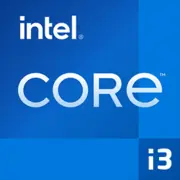Intel Core i3-1220P

Intel Core i3-1220P: A Versatile Processor for Everyday Tasks in 2025
March 2025
Architecture and Technology Process: Hybrid Power of Alder Lake
The Intel Core i3-1220P processor, released in 2022, is part of the groundbreaking Alder Lake generation. Its hybrid architecture combines 2 performance cores (P-cores) and 8 efficient cores (E-cores), resulting in a total of 10 cores and 12 threads (P-cores support Hyper-Threading). The Intel 7 process (formerly known as 10nm Enhanced SuperFin) provides a balance between power and energy efficiency.
- Clock Frequencies: The base frequency of P-cores is 1.5 GHz, with a maximum turbo frequency of 4.4 GHz. E-cores operate in the range of 1.1–3.3 GHz.
- Cache: 12 MB of L3 cache speeds up data processing in multitasking scenarios.
- Integrated Graphics: Intel UHD Graphics for the 12th generation features 64 execution units (EUs). Supports 4K/60Hz, HDMI 2.1, and AV1 decoding.
The hybrid architecture automatically distributes tasks: P-cores handle demanding applications (like Photoshop), while E-cores manage background processes (updates, streaming). This reduces power consumption without sacrificing system responsiveness.
Power Consumption and TDP: Balance Between Performance and Battery Life
The nominal TDP of the processor is 28W, but in practice, it can consume up to 35–40W in turbo mode. This makes it suitable for thin ultrabooks and devices with active cooling.
- Thermal Design: Laptops with the i3-1220P often come with compact coolers that handle the load but may make noise under prolonged Turbo operation.
- Energy Efficiency: Compared to the 11th generation (Tiger Lake), Alder Lake has reduced power consumption by 10–15% due to optimizations in E-core design.
Performance: Real-World Tasks and Turbo Mode
Geekbench 6 (1961 single-core / 6895 multi-core) shows solid performance for an entry-level processor.
- Office Work: Easily handles 20+ tabs in Chrome, Microsoft Office, and Zoom conferences.
- Multimedia: Photo editing in Lightroom is smooth, and rendering 1080p video in Premiere Pro takes 2–3 minutes (compared to 1.5 minutes for the Ryzen 5 7530U).
- Gaming: Integrated graphics can run CS2 on low settings (60–70 FPS), but Forza Horizon 5 will run at 20–25 FPS.
Turbo Boost: During short bursts of load (like opening a heavy Excel file), the frequency of P-cores jumps to 4.4 GHz. However, after 20–30 seconds, the system may throttle due to overheating in compact cases.
Use Case Scenarios: Who is the i3-1220P for?
- Students: Text work, online courses, light presentation editing.
- Office Workers: Multitasking between email, spreadsheets, and browsers.
- On-the-Go Users: Watching Netflix, social media, cloud services.
Not Suitable For:
- Gamers demanding Ultra settings.
- Professionals in 3D rendering or 4K editing.
Battery Life: How Long Will the Laptop Last?
With a battery capacity of 50–60 Wh (typical for ultrabooks in 2025):
- Web browsing: 6–8 hours.
- Video (1080p): 9–10 hours (thanks to hardware AV1 decoding).
- Load (Photoshop + browser): 3–4 hours.
Energy-Saving Technologies:
- Intel Dynamic Tuning 2.0: Adaptively adjusts TDP based on load.
- Speed Shift: Reduces latency when switching modes.
Comparison with Competitors: AMD, Apple, and Previous Generations
- AMD Ryzen 5 7530U (Zen 3): 6 cores / 12 threads, TDP 15–25W. Better in multi-threaded tasks (Geekbench Multi ~7200) but weaker in single-threaded (~1850).
- Apple M1: 8 cores (4+4), Geekbench Multi ~7500. Excels in battery life (up to 15 hours) and graphics performance but is limited by macOS and software compatibility.
- Intel Core i5-1135G7 (11th generation): Falls short compared to the i3-1220P by 20–25% in multi-threading.
Pros and Cons
Strengths:
- High single-thread performance for office tasks.
- Supports DDR5-4800 and PCIe 4.0 (fast SSDs).
- Thunderbolt 4 for connecting 4K monitors and peripherals.
Weaknesses:
- Weaker graphics compared to AMD Radeon 660M.
- Fewer E-cores compared to i5/i7 Alder Lake.
- Heating in thin cases.
Laptop Selection Recommendations
- Device Type: Ultrabooks (e.g., Lenovo Yoga Slim 7i), budget laptops (HP 255 G9).
- What to Look For:
- Cooling: Dual fans are better than one.
- RAM: At least 16GB DDR5.
- Screen: IPS matrix with 300 nits brightness.
- Price: $700–900 for new models in 2025.
Avoid devices with HDDs and 8GB of RAM as these can bottleneck performance.
Final Conclusion
The Intel Core i3-1220P remains a relevant choice in 2025 for those seeking a balance of price and performance. It’s ideal for:
- Everyday tasks (office work, study, entertainment).
- Users valuing portability and Thunderbolt 4.
- Those not wanting to overpay for "extra" cores in i5 or Ryzen 5.
If you need a laptop priced at $700–900 with reliable battery life and sufficient power for basic tasks, the i3-1220P is your option. For gaming or professional work, look towards models with discrete GPUs or processors at the level of Core i5/Ryzen 7.
Basic
CPU Specifications
Memory Specifications
GPU Specifications
Miscellaneous
Benchmarks
Compared to Other CPU
Share in social media
Or Link To Us
<a href="https://cputronic.com/cpu/intel-core-i3-1220p" target="_blank">Intel Core i3-1220P</a>